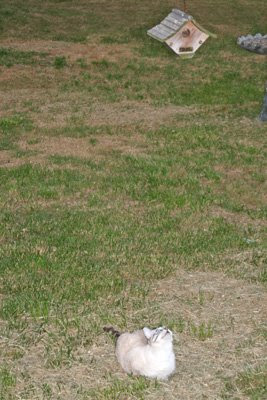 This is the first Eastern Towhee we've seen this year. The white stripes along their tail really stand out when they are in flight. This one is eating the bits on the ground under the squirrel feeder.
This is the first Eastern Towhee we've seen this year. The white stripes along their tail really stand out when they are in flight. This one is eating the bits on the ground under the squirrel feeder.The Quilting Tangler... See what keeps me busy -- quilting, judging, Zentangle art, writing books (I have 13 books published by AQS on quiltmaking, Zentangle Art To Go, and one family cookbook -- Cooking with the Kirklands), my travels, and my favorite hobby - photography... AND what we are doing at the AQS QuiltWeek events. I am a Certified Quilt Judge, and a Certified Zentangle Teacher®. For information on teaching, go to my website: www.bonniebrowning.com.
Saturday, May 31, 2008
Eastern Towhee
 This is the first Eastern Towhee we've seen this year. The white stripes along their tail really stand out when they are in flight. This one is eating the bits on the ground under the squirrel feeder.
This is the first Eastern Towhee we've seen this year. The white stripes along their tail really stand out when they are in flight. This one is eating the bits on the ground under the squirrel feeder.Improper Eating Manners, GRIN

Saturday, May 24, 2008
Indigo Bunting
 I thought you would enjoy seeing a young indigo bunting in this flowering tree. This one is just getting color. Did you know that they really have black feather and it is the light refracting that makes them look blue. Some of them will look like they have black feathers in their wings and tail sections. I like to photograph them when they are sitting in the late afternoon sun when they look such a gorgeous blue.
I thought you would enjoy seeing a young indigo bunting in this flowering tree. This one is just getting color. Did you know that they really have black feather and it is the light refracting that makes them look blue. Some of them will look like they have black feathers in their wings and tail sections. I like to photograph them when they are sitting in the late afternoon sun when they look such a gorgeous blue.Tulip Poplar tree
Little Tubby
Friday, May 23, 2008
Kitty Lust
Monday, May 19, 2008
Whitesocks goes to Kitty Heaven Today

Sunday, May 18, 2008
The National Quilt Museum

The National Quilt Museum
MAQS recognized as The National Quilt Museum

Yesterday, May 17, Congressman Whitfield presented quilt museum founders Bill and Meredith Schroeder with the Congressional Record proclaiming the Museum of the American Quilter's Society as The National Quilt Museum.
The ceremony was attended by staff members of Senator Mitch McConnell and Congressman Whitefield, city and county officials, present and past MAQS Board members, Friends of MAQS, Paducah Ambassadors, quilters, and others interested in quilting and the quilt museum.
Thursday, May 15, 2008
Armadillo - born dead along side the road GRIN

Armadillos are prolific diggers. Many species use their sharp claws to dig for food, such as grubs, and to dig dens. The Nine-banded Armadillo prefers to build burrows in moist soil near the creeks, streams, and arroyos near which it lives and feeds. The diet of different armadillo species varies, but consists mainly of insects, grubs, and other invertebrates. Some species, however, are almost entirely formicivorous (feeding mainly on ants).
Armadillos have poor vision but are not blind.
This armor-like skin appears to be the main defense of many armadillos, although most escape predators by fleeing (often into thorny patches, from which their armor protects them) or digging to safety. The North American Nine-banded Armadillo tends to jump straight in the air when surprised, and consequently often collides with the undercarriage or fenders of passing vehicles -- guess that explains why there are so many along the road.
Saturday, May 3, 2008
Jenny Wren
Rose-breasted Grosbeak
Hairy and Downy Woodpeckers

We also get a few pileated woodpecker sightings, and lots of red-bellied woodpeckers (larger than either of these).
Indigo Buntings
Hummers are back














